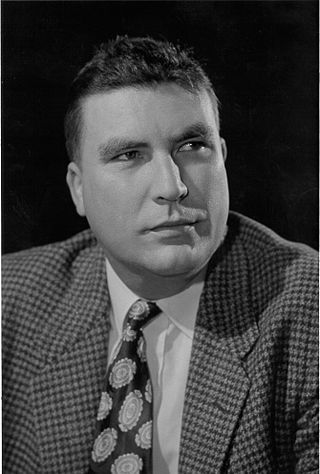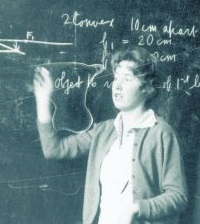
Ernest Orlando Lawrence was an American nuclear physicist and winner of the Nobel Prize in Physics in 1939 for his invention of the cyclotron. He is known for his work on uranium-isotope separation for the Manhattan Project, as well as for founding the Lawrence Berkeley National Laboratory and the Lawrence Livermore National Laboratory.

The Bulletin of the Atomic Scientists is a nonprofit organization concerning science and global security issues resulting from accelerating technological advances that have negative consequences for humanity. The Bulletin publishes content at both a free-access website and a bi-monthly, nontechnical academic journal. The organization has been publishing continuously since 1945, when it was founded by Albert Einstein and former Manhattan Project scientists as the Bulletin of the Atomic Scientists of Chicago immediately following the atomic bombings of Hiroshima and Nagasaki. The organization is also the keeper of the symbolic Doomsday Clock, the time of which is announced each January.

Willard Frank Libby was an American physical chemist noted for his role in the 1949 development of radiocarbon dating, a process which revolutionized archaeology and palaeontology. For his contributions to the team that developed this process, Libby was awarded the Nobel Prize in Chemistry in 1960.

Herbert Frank York was an American nuclear physicist of Mohawk origin. He held numerous research and administrative positions at various United States government and educational institutes.

Ben Roy Mottelson was an American-Danish nuclear physicist. He won the 1975 Nobel Prize in Physics for his work on the non-spherical geometry of atomic nuclei.
Bernard Taub Feld was a professor of physics at the Massachusetts Institute of Technology. He helped develop the atomic bomb, and later led an international movement among scientists to banish nuclear weapons.

Jerome Isaac Friedman is an American physicist. He is institute professor and professor of physics, emeritus, at the Massachusetts Institute of Technology. He won the 1990 Nobel Prize in Physics along with Henry Kendall and Richard Taylor, "for their pioneering investigations concerning deep inelastic scattering of electrons on protons and bound neutrons, which have been of essential importance for the development of the quark model in particle physics.", work which showed an internal structure for protons later known to be quarks. Friedman sits on the board of sponsors of the Bulletin of the Atomic Scientists.

Paul Hermann Scherrer was a Swiss physicist. Born in St. Gallen, Switzerland, he studied at Göttingen, Germany, before becoming a lecturer there. Later, Scherrer became head of the Department of Physics at ETH Zurich.

Homi Jehangir Bhabha, FNI, FASc, FRS(30 October 1909 to 24 January 1966) was an Indian nuclear physicist who is widely credited as the "father of the Indian nuclear programme". He was the founding director and professor of physics at the Tata Institute of Fundamental Research (TIFR), as well as the founding director of the Atomic Energy Establishment, Trombay (AEET) which was renamed the Bhabha Atomic Research Centre in his honour. TIFR and AEET served as the cornerstone to the Indian nuclear energy and weapons programme. He was the first chairman of the Indian Atomic Energy Commission and secretary of the Department of Atomic Energy. By supporting space science projects which initially derived their funding from the AEC, he played an important role in the birth of the Indian space programme.

David Allan Bromley was a Canadian-American physicist, academic administrator and science advisor to President George H. W. Bush. His field of research was the study of low-energy nuclear reactions and structure using heavy ion beams.

Edward Uhler Condon was an American nuclear physicist, a pioneer in quantum mechanics, and a participant during World War II in the development of radar and, very briefly, of nuclear weapons as part of the Manhattan Project. The Franck–Condon principle and the Slater–Condon rules are co-named after him.

Eugene Rabinowitch was a Russian-born American biophysicist who is known for his work in photosynthesis and nuclear energy. He was a co-author of the Franck Report and a co-founder in 1945 of the Bulletin of the Atomic Scientists, a global security and public policy magazine, which he edited until his death.

Steven Chu is an American physicist and former government official. He is a Nobel laureate and was the 12th U.S. secretary of energy. He is currently the William R. Kenan Jr. Professor of Physics and Professor of Molecular and Cellular Physiology at Stanford University. He is known for his research at the University of California, Berkeley, and his research at Bell Laboratories and Stanford University regarding the cooling and trapping of atoms with laser light, for which he shared the 1997 Nobel Prize in Physics with Claude Cohen-Tannoudji and William Daniel Phillips.
The International Conference on the Physics of Semiconductors is a biennial conference series on semiconductor science. This biennial meeting is the premier forum for reporting all aspects of semiconductor physics including electronic, structural, optical, magnetic and transport properties. The conference will reflect the state of the art in semiconductor physics with a heritage dating back to the 1950s.
William Albert Noyes Jr., commonly known as W. Albert Noyes Jr., was an American chemist known for his contributions to photochemistry. During World War II, he was a leader in U.S. defense research efforts. He chaired the chemistry department at the University of Rochester, edited several important chemistry journals, and throughout his career was a prominent voice for international scientific cooperation. He was the son of the renowned chemist William A. Noyes; they became the first father-son pair to win the Priestley Medal, the highest honor given by the American Chemical Society.
H. Pierre Noyes was an American theoretical physicist. He became a member of the faculty at the SLAC National Accelerator Laboratory at Stanford University in 1962. Noyes specialized in several areas of research, including the relativistic few-body problem in nuclear and particle physics.

Oleksander Yakovych Shulhyn was a Ukrainian politician, academic, and diplomat who played a key role in establishing the Ministry of Foreign Affairs of Ukraine. He was a member of the Shevchenko Scientific Society, a professor of the Ukrainian Free University in Prague, a member of the Ukrainian delegation at the Paris Peace Conference, 1919 and a representative of Ukrainians in International Refugee Organization after World War II. During World War II Shulhyn acted as head of the Government of the Ukrainian People's Republic in exile.
Nathan Solon Finney, who wrote under the name Nat S. Finney, was an American journalist. He spent long periods as a Washington correspondent for the Minneapolis Tribune and, later, the Buffalo Evening News. A specialist on economics and nuclear energy, he covered atomic tests in the Pacific, was the first journalist to visit Los Alamos National Laboratory, and was the first to report on Soviet missiles in Cuba.
Alex Wellerstein is a historian of science at the Stevens Institute of Technology who studies the history of nuclear weapons. He is the creator of NUKEMAP.

Anne Kernan was an Irish particle physicist.













